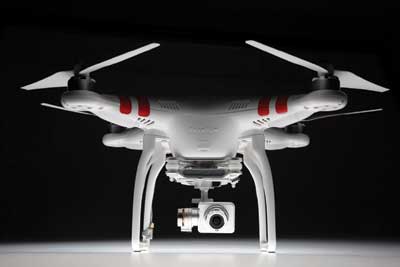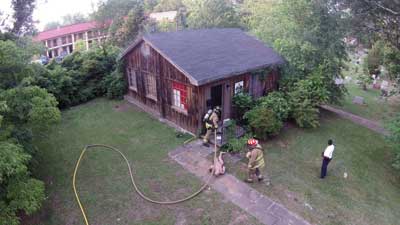By Matt Sloane
They’ve been used by the United States military and armed forces around the world to rain destruction on our enemies from afar and are controlled by pilots in a windowless, air-conditioned, video-game-like room at a military base in Nevada.
Those aren’t the drones we’re talking about here, and while remotely flying a multimillion-dollar aircraft with missiles on it may be every little kid’s dream, you can have just as much fun with a very useful, much less expensive system.
These drones-or unmanned aerial vehicles (UAVs) as we’ll call them-are being adopted by realtors, filmmakers, farmers, and hobbyists alike. They’re also being used successfully by many fire departments, search and rescue teams, and law enforcement agencies, and they just may save a life.
 |
| 1 The DJI Phantom Vision 2+ is a market leader in lightweight, easy-to-use UAVs. (Photo courtesy of DJI.) |
An increasing number of private citizens are showing up during emergencies with their drones, and it’s important to understand how the technology works, where UAVs may be useful to you as an incident commander (IC), and when they can do more harm than good.
UAV Use in Public Safety
The potential uses for UAVs in the fire service are numerous, including active fire surveillance, thermal imaging, hazmat response, traffic and crowd oversight, public relations and marketing, and coverage of special events.
Take the case of a standard house fire. The first engine on scene rolls up on a two-story dwelling with smoke pouring out of the attic vents and no visible flames.
Step 1 is the scene size-up, where one or more firefighters take the time to walk around the structure and assess the fire from each side. They report back to the IC, and the fire suppression portion of the event begins.
But, what if all four sides aren’t visible? What if your agency is a volunteer agency, and there’s only one firefighter on the first-in vehicle? When seconds count, critical resources are being used to size up a scene before taking any action.
Enter a UAV. The first responding firefighter takes 30 seconds to get the aircraft up and running; puts it into the air; and, from the command vehicle, has a live view of all four sides of the structure.
Additional responding companies can use those real-time images to plan the attack, see the best places to park the apparatus, keep track of responding personnel, see active fire hot spots, and potentially even see victims hanging out of open windows or on balconies.
Although setting up the UAV may take as much time as the initial scene size-up, the amount of information gathered is significantly higher.
The benefits of UAVs are multiplied even more in a high-rise fire, where it may take crews several minutes to size up a fire on the 10th floor, or in a hazmat situation, where specialized teams and gear need to be brought in before anybody knows what’s really happening at the site.
It’s also important to consider when flying a UAV may not be appropriate. Strong winds and rain may make flying difficult, and you should never fly within an area where you may encounter low-flying commercial or private air traffic.
Flying too close to strong thermal updrafts around a fire could damage your equipment permanently, and personnel should avoid flying low over large crowds.
 |
| 2 The Decatur (GA) Fire Department trains on house fire entry procedures as seen from a UAV. (Photo courtesy of Atlanta Drone Consultants.) |
UAV Technology
As the market for UAVs grows, so does the number of companies making them. By far, the most popular is China-based manufacturer DJI, and its most popular model is the Phantom.
The Phantom comes in different forms: the original Phantom; the Phantom 2; the Phantom 2+, which come without cameras attached; and the Phantom Vision 2+, which includes a proprietary camera.
Out of the box, the Phantom Vision 2+ is the easiest of the lineup to use and comes with the most advanced features. The Vision 2+ boasts a 1,080-pixel video camera, which takes 14-megapixel stills and lives on a three-axis, image-stabilizing gimbal.
The Vision 2+ transmits live video signals back to a smartphone or tablet over a self-contained, long-range WiFi signal and will fly in up to 25 mile-per-hour winds.
It features a ½-mile flight range from the flight controller and, in the right conditions, can fly as high as a ¼ mile. Each flight battery lasts about 25 minutes and takes just over an hour to recharge.
There are dozens of other options on the market, and each has a robust set of features, but price, ease of use, and certain tradeoffs make them less appealing for the masses.
The MicroDrone MD4-1000 features a significantly longer flying time than the Phantom, clocking in at up 88 minutes in the air. The MicroDrone gives users the ability to do both thermal and daylight video and switch them on the fly.
The Aeryon Scout is another viable option for public safety and features a 10x optical zoom camera and the ability to do both daylight and IR as well.
There are also several fixed-wing UAVs that could be useful for long-range surveillance flights and tethered options, which can be suitable for long-duration crowd or construction-site surveillance.
Legal Considerations
One of the clearest concerns for most people about UAVs is whether or not it’s legal to fly them. The answer, however, is significantly less clear.
In an effort to simplify a very complicated answer, it’s worthwhile to break down the legal aspects into three distinct categories: hobby use, commercial use, and public-sector use.
Hobby Use
As it stands today, there are currently no federal laws banning the use of UAVs for hobbyists, although a 1981 set of guidelines for using model aircraft is often cited as the most applicable set of rules for this group. These include flying at a maximum altitude of 400 feet and restricting operations to areas without buildings or heavy air traffic. But, these guidelines were just that-a guide-and aren’t considered enforceable by law.
Commercial Use
Although the Federal Aviation Administration (FAA) has stated that UAVs are illegal for use by any commercial entities, it’s not clear whether any current rules prohibit UAV use for this purpose.
Two high-profile court cases, Huerta v. Pirker and Texas EquuSearch Mounted Search and Recovery Team v. FAA, have muddied the waters even further.
In the Pirker case, the FAA assessed aerial videographer Raphael Pirker a $10,000 fine after he was hired to shoot aerial video of the University of Virginia. However, the basis for the fine was not Pirker’s use of the UAV or for his operation of the UAV for commercial purposes. Rather, the FAA cited him for reckless flying.
Ultimately, an administrative law judge for the National Transportation Safety Board (NTSB) overturned the fine on the grounds that the FAA had no legal standing to impose the fine in the first place.
Similarly in the Texas EquuSearch (TES) case, the nonprofit organization was using UAVs to search for missing children, and the FAA sent the group a cease-and-desist letter. TES appealed the ruling, and a federal appeals court judge held that because TES was not receiving any compensation for its services, the very nature of banning its activities as “commercial use of a drone” was a nonstarter.
Public-Sector Use
The picture is somewhat clearer for public-sector agencies, where a formalized approval process for using UAVs is in place. The process involves obtaining a Certificate of Authorization, or COA, as a specific exemption to what the FAA says is an outright ban on UAVs.
The COA process can be a lengthy one and requires public safety agencies to identify specific pilots, flight plans, type of aircraft, criteria for operation, standard operating procedures, and emergency recovery procedures. It also requires that designated pilots complete FAA private-pilot ground school training-like a manned aircraft pilot would do-and obtain an FAA Class III medical certificate by getting a physical exam with a certified aviation medical examiner. In addition, the COA process requires that applicants purchase their aircraft before going through the process and log training hours in a controlled setting before getting approval to fly during emergency operations.
COAs are valid for a two-year period and need to be renewed.
State Laws
Currently, 17 states have enacted a total of 20 laws addressing UAVs, and legislation has been proposed in a total of 30 states. The majority of these state laws focus on privacy issues, which can arise from law enforcement use of UAVs for surveillance, trespassing, and weaponizing drones. There are no state laws that explicitly restrict using UAVs for fire prevention or suppression purposes, and many states with legal limitations on UAVs have exclusions for search and rescue operations.
Future Regulation
Two years ago, Congress passed the FAA Modernization and Reform Act of 2012, in which it directs the FAA to develop a plan for regulating UAVs. The FAA has indicated that it expects a draft of those regulations to be released in late 2014, followed by a comment period. It hopes to have a new framework in place by the end of 2015. This could be good news for public safety agencies, which may have an easier time navigating these new regulations than the current COA process.
Despite a fairly involved process to obtain a COA from the FAA, most public safety operators at the forefront of the UAV movement agree that in this case the benefits to human life and personnel safety far outweigh the difficulty in getting these programs approved.
MATT SLOANE is an EMT-Intermediate and the president of Atlanta Drone Consultants, a company focused on providing guidance, product, and education to public safety agencies looking to implement UAV programs.

